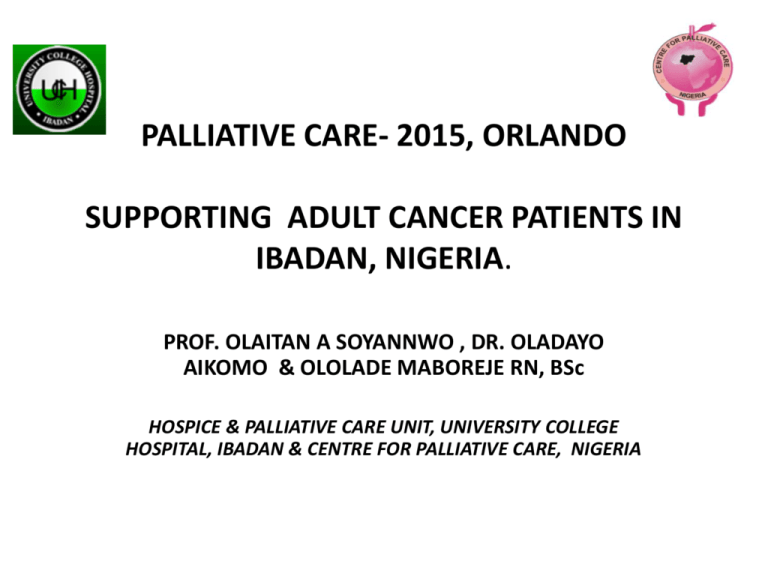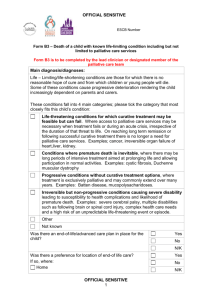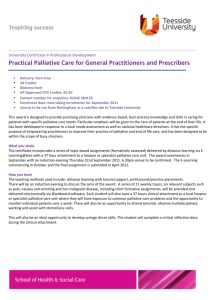palliative care: supporting the adult cancer patient in ibadan,nigeria.
advertisement

PALLIATIVE CARE- 2015, ORLANDO SUPPORTING ADULT CANCER PATIENTS IN IBADAN, NIGERIA. PROF. OLAITAN A SOYANNWO , DR. OLADAYO AIKOMO & OLOLADE MABOREJE RN, BSc HOSPICE & PALLIATIVE CARE UNIT, UNIVERSITY COLLEGE HOSPITAL, IBADAN & CENTRE FOR PALLIATIVE CARE, NIGERIA Greetings from---Nigeria, University College Hospital, Ibadan & Centre for Palliative Care, Nigeria team 2 Nigeria • • • • • Largest country in Africa Population 170 million 250 cultural tribes 36 States + FCT Religion : Islam(50.5%). Christianity(48.2%), Others(1.4%). • Low MDGs despite oil wealth! • Health agenda at Federal and State levels • Emphasis on communicable disease prevention/treatment • NCDs and Pain issues emerging area of interest • Bulk of health funding is borne by households (out of pocket payment) SOYANNWO O A 2015 3 Cancer • One of the leading causes of adult death. • Recent new cases of cancer diagnosed in Africa in 2008 and Nigeria in 2010 is 715,000 and 500,000 respectively. [1] [1] Jemal A, Bray F, Forman D, O’Brien M. Ferlay J, Center M, Parkin M. Cancer burden in Africa and opportunities for prevention. Cancer. 2012; 118(18):4372-4384 SOYANNWO O A 2015 4 Palliative care in Nigeria • Advocacy commenced in 1991 • Few trained health professionals (mainly at Hospice Africa Uganda) • 8 functional palliative care centres in tertiary hospitals • No stand alone Hospice • Hospice and Palliative care association ( HPCAN) inaugurated in 2007 • Opioid availability and accessibility problematic SOYANNWO O A 2015 5 Day care Hospice and Palliative care centre, UCH, Ibadan • Established in collaboration with Centre for Palliative Care, Nigeria (CPCN), an NGO in 2007. • Structured services commenced in 2008. • Team of trained palliative care staff - doctors, nurses, social worker, admin staff and volunteers SOYANNWO O A 2015 6 STUDY OBJECTIVES • To review palliative care services offered to caner patients by the Hospice and Palliative care Unit of the University College Hospital (UCH), Ibadan • To identify challenges • Review outcome of service • Proffer way forward SOYANNWO O A 2015 7 Methodology • Retrospective study of patients seen over a period of one year (January – December 2013) • Information retrieved from case files include bio-data, stage of cancer, presenting complaints, palliative care issues identified, services rendered, days on programme, outcome and challenges encountered. • Data shown in a simple descriptive format. SOYANNWO O A 2015 8 Results • Total number of patients seen at the hospice during study period 189. • Adult cancer patients = 121 ( 64%) • Stage of disease – Advanced (96.7% stage IV) • Male : Female = 1:1.8 • Religion = Muslim 67(55%) Christian 54(45%) • Age range = 21-91years( Mean age= 59 (SD+/-15) • Days on programme ranged from 5-224 days. SOYANNWO O A 2015 9 Results • AGE DISTRIBUTION Age( Years) N % 18-35 11 9.1 36-53 24 19.8 54-71 78 64.5 72-89 5 4.1 >90 3 2.5 121 100.0 Total SOYANNWO O A 2015 10 Diagnosis Diagnosis N % Breast carcinoma 29 23.9 Gastrointestinal cancers 24 19.8 Prostatic carcinoma 17 14.0 Cervical carcinoma 14 11.6 Other gynae-oncological carcinoma 12 9.9 Head/neck cancers 12 9.9 Blood cancers 4 3.3 Lung cancers 4 3.3 Other urological cancers 3 2.5 Osteosarcoma 2 1.7 Peripheral nerve sheath tumor 1 0.8 121 100.0 Total 11 Palliative care issues identified Palliative care issues Number of patients % (n =121) Psychosocial + Pain 79 65.3 Psychosocial + spiritual + Pain 53 43.8 Spiritual + Pain 37 30.6 Unconscious 12 9.9 SOYANNWO O A 2015 12 PAIN : 89/121(73.6%). Number of pain site (s) Pain score (NRS) Number of pain site(s) Pain score N % N % 1 70 79 1-3 0 0 2 12 13 4-7 62 70 >3 7 8 8-10 27 30 Total 89 100 Total 89 100 SOYANNWO O A 2015 13 Other symptoms Symptoms Number of patients % (n= 121) Weight loss and anorexia 86 71.07 Nausea ,vomiting and dry mouth 65 53.7 Weight loss and cough 38 31.4 Nausea and anorexia 24 19.8 SOYANNWO O A 2015 14 Pain and other symptoms control 80 (90%) had their pain controlled. MEDICATIONS Medications OTHER MODES OF TREATMENT N % Strong opioid+ NSAIDs + adjuvant 54 61 Weak opioids + adjuvant 19 21 NSAID + non-opioid 10 11 6 7 89 100 Weak opioids + NSAID Total Modes of treatment N % Chemo -radiotherapy 42 35 Radiotherapy 27 22 Chemotherapy + surgery 27 22 Chemotherapy 12 10 Surgery + chemoradiotherapy 10 8 3 3 121 100 Hormonal Total SOYANNWO O A 2015 15 Other interventions • Financial Support (through the NGO, CPCN) • Comfort packs, subsidy of the cost of medications(morphine). • Psychotherapy sessions • Involvement of occupational therapist, physiotherapist and social workers. • Spiritual care (hospital chaplaincy committee) • Family conferences SOYANNWO O A 2015 16 Spiritual care, herbal and traditional remedies also favored by patients SOYANNWO O A 2015 17 Outcome Outcome N % Dead 82 68 Alive 24 20 Lost to contact 15 12 Total 121 100 SOYANNWO O A 2015 18 Discussion • Late presentation/referral • Most presented with moderate to severe pain. • Morphine- the only strong opioid available • Less spiritual issues due to role of religious beliefs. • Financial support – Centre for Palliative Care, Nigeria (NGO) collaboration SOYANNWO O A 2015 19 Challenges • Late referrals • Poverty and severe financial constraint • Interrupted supply of strong opioid/restricted opioid switch. • Myth concerning use of oral morphine • Limitation of service to 20km radius • Poor knowledge about palliative care – public, policy makers, health professionals SOYANNWO O A 2015 20 Conclusion • Palliative care service was found to be beneficial to the patients enrolled on the programme and their families • Pain is a major problem and availability of opioid analgesics is essential for better management. • Such care can be improved with adequate collaboration and partnerships. • Improved education and policy will enhance extension to community level. SOYANNWO O A 2015 21 From our team - Thank you for listening. SOYANNWO O A 2015 22








